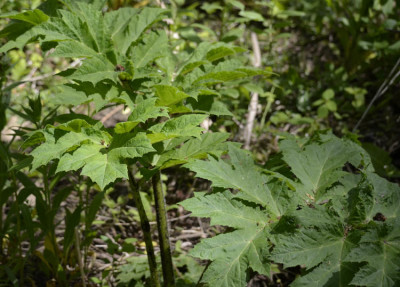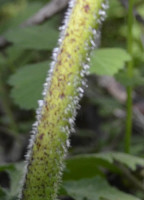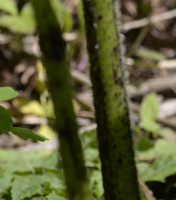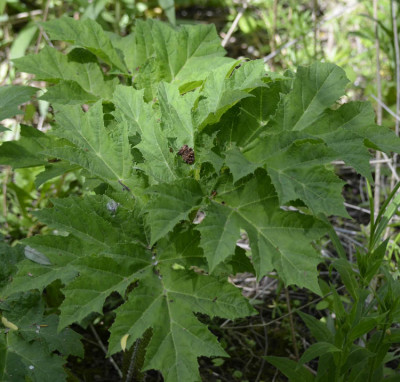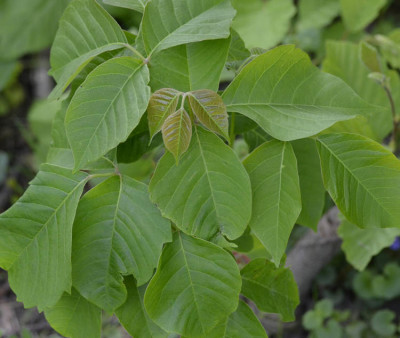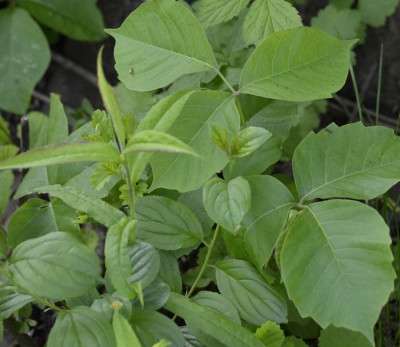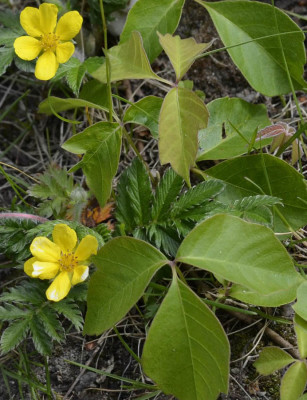As spring progresses and the green growing plants shoot up to new heights, I have made two unexpected and somewhat dangerous discoveries in parks I visit. Yesterday I met another person enjoying the natural sights and warned him that the lush greenery inches from his bare legs was poisonous. He hadn’t known. In case you don’t know either, here’s what to watch out for.
Giant Hogweed: A Potentially Serious Menace that’s New to Ontario
When I was growing up, the two plants we learned to avoid were Poison Ivy and Poison Oak. A new pest has arrived in Ontario, however. It’s called Giant Hogweed. When mature, it can tower 4-6 m (12-18 feet) in height. The leaves are enormous. Its flowers are large umbrellas of small white blooms, looking a bit like Queen Anne’s Lace.
However, like all plants, Giant Hogweed starts small. In fact, it is a biennial and doesn’t usually bloom until its second year. It was two of these younger plants that I spotted recently in among the huge burdock leaves in Lakeside Park.
Giant Hogweed can be genuinely dangerous. If the sap comes into contact with skin, it reacts. A few days later, particularly if that damaged skin is exposed to sunlight, a horrible blistering rash develops. It can cause serious damage and permanent scarring. Because it takes several days to develop a person may not even know they have been exposed.
A gruesome photo of an affected person’s arm is at http://www.peelregion.ca/health/environNew/outdoors/hogweed.htm
While it’s difficult to imagine accidentally trampling down or against a plant taller than you are, it is quite possible to walk bare-legged into it while it’s still only two feet tall. I nearly did. It’s only because I prefer to step around plants rather than risk damaging them by treading on them that I noticed the young Hogweed in the first place.
Because people could go blind from extreme exposure to Giant Hogweed, and because it is still a new invasive, most regions are trying to exterminate the plants before they spread and settle in.
If you see Giant Hogweed, take a minute to search the internet and call the local government to report it. (For example, in Mississauga, call 311.) Then they can use herbicides or other measures to safely kill the plants before they flower, set seed and spread.
Less Deadly but Much More Itchy Poison Ivy is Common throughout Southern Ontario
Poison ivy is quite common in most parks I’ve visited in southern Ontario that have naturalized areas. Several species of birds eat poison ivy berries and drop the seeds in new spots as they fly. Poison ivy also comes in a variety of styles and shapes that make it easy to overlook.
Note the almost toothless leaves on THIS plant.
Here are some views of the bumper crop growing in Arkendo Park, Oakville. The most luxurious plants are along the edge of the beach where the creek meets the Lake.
Note the quite toothy leaf on THIS plant.
Exposure to poison ivy sap results in large water-filled blisters and a horrible intense itching. Scratching can move the oils to other parts of the body increasing the problem. Unfortunately, if your dog goes bounding through poison ivy and gets the sap on its fur, when you pet your dog, you can unknowingly get the sap on your hands and then elsewhere on your body. Another good reason to keep your dog leashed.
Here the Poison Ivy is growing entangled with an attractive wildflower. Sneaky!
Parks departments cannot control poison ivy everywhere so you really do have to learn how to recognize it and stay away.
Related Reading
Join In
Have you had a run-in with a poisonous plant? What steps would you suggest to save other souls? Please share your experiences with a comment.

